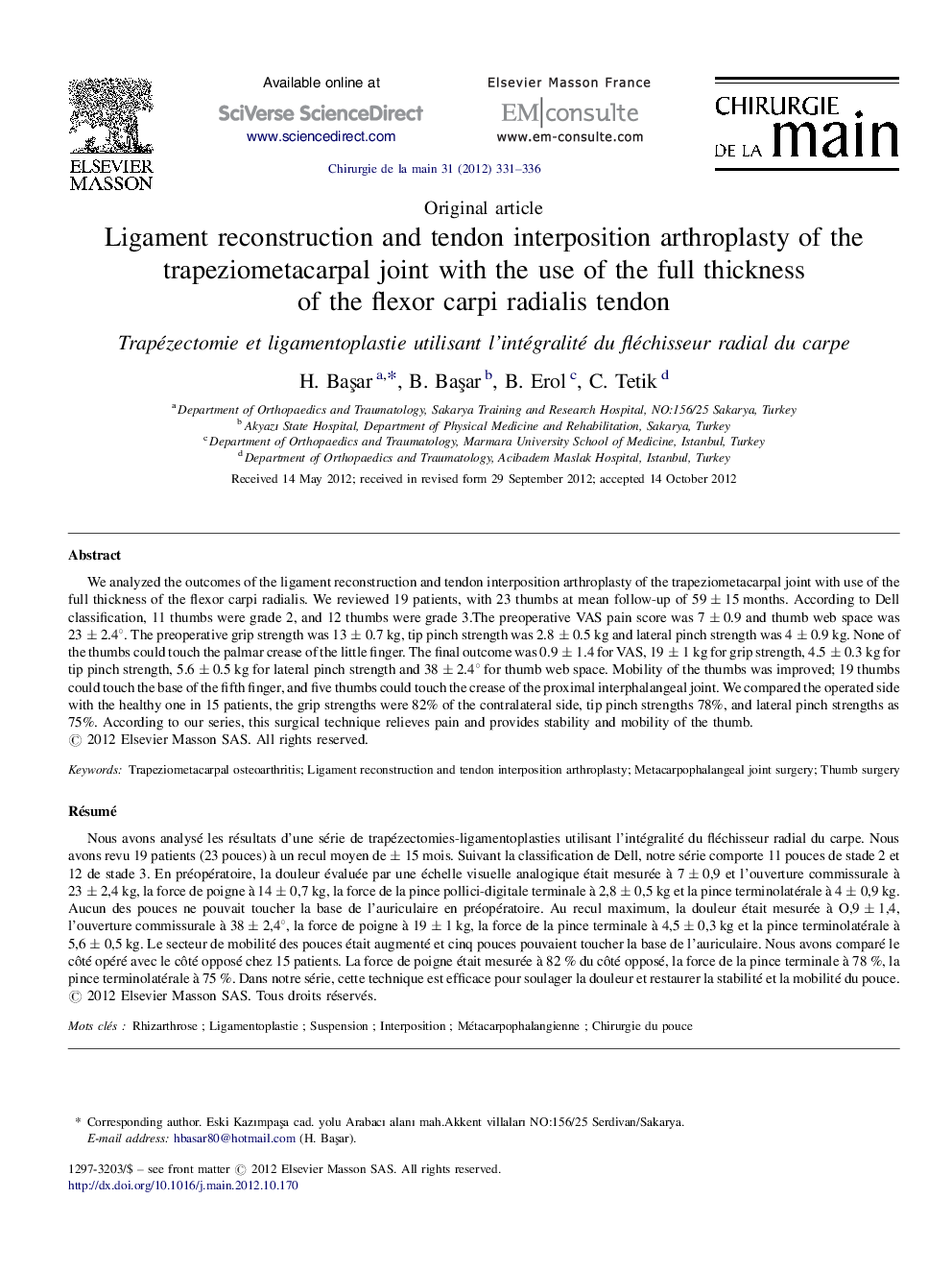| Article ID | Journal | Published Year | Pages | File Type |
|---|---|---|---|---|
| 4048970 | Chirurgie de la Main | 2012 | 6 Pages |
We analyzed the outcomes of the ligament reconstruction and tendon interposition arthroplasty of the trapeziometacarpal joint with use of the full thickness of the flexor carpi radialis. We reviewed 19 patients, with 23 thumbs at mean follow-up of 59 ± 15 months. According to Dell classification, 11 thumbs were grade 2, and 12 thumbs were grade 3.The preoperative VAS pain score was 7 ± 0.9 and thumb web space was 23 ± 2.4°. The preoperative grip strength was 13 ± 0.7 kg, tip pinch strength was 2.8 ± 0.5 kg and lateral pinch strength was 4 ± 0.9 kg. None of the thumbs could touch the palmar crease of the little finger. The final outcome was 0.9 ± 1.4 for VAS, 19 ± 1 kg for grip strength, 4.5 ± 0.3 kg for tip pinch strength, 5.6 ± 0.5 kg for lateral pinch strength and 38 ± 2.4° for thumb web space. Mobility of the thumbs was improved; 19 thumbs could touch the base of the fifth finger, and five thumbs could touch the crease of the proximal interphalangeal joint. We compared the operated side with the healthy one in 15 patients, the grip strengths were 82% of the contralateral side, tip pinch strengths 78%, and lateral pinch strengths as 75%. According to our series, this surgical technique relieves pain and provides stability and mobility of the thumb.
RésuméNous avons analysé les résultats d’une série de trapézectomies-ligamentoplasties utilisant l’intégralité du fléchisseur radial du carpe. Nous avons revu 19 patients (23 pouces) à un recul moyen de ± 15 mois. Suivant la classification de Dell, notre série comporte 11 pouces de stade 2 et 12 de stade 3. En préopératoire, la douleur évaluée par une échelle visuelle analogique était mesurée à 7 ± 0,9 et l’ouverture commissurale à 23 ± 2,4 kg, la force de poigne à 14 ± 0,7 kg, la force de la pince pollici-digitale terminale à 2,8 ± 0,5 kg et la pince terminolatérale à 4 ± 0,9 kg. Aucun des pouces ne pouvait toucher la base de l’auriculaire en préopératoire. Au recul maximum, la douleur était mesurée à O,9 ± 1,4, l’ouverture commissurale à 38 ± 2,4°, la force de poigne à 19 ± 1 kg, la force de la pince terminale à 4,5 ± 0,3 kg et la pince terminolatérale à 5,6 ± 0,5 kg. Le secteur de mobilité des pouces était augmenté et cinq pouces pouvaient toucher la base de l’auriculaire. Nous avons comparé le côté opéré avec le côté opposé chez 15 patients. La force de poigne était mesurée à 82 % du côté opposé, la force de la pince terminale à 78 %, la pince terminolatérale à 75 %. Dans notre série, cette technique est efficace pour soulager la douleur et restaurer la stabilité et la mobilité du pouce.
